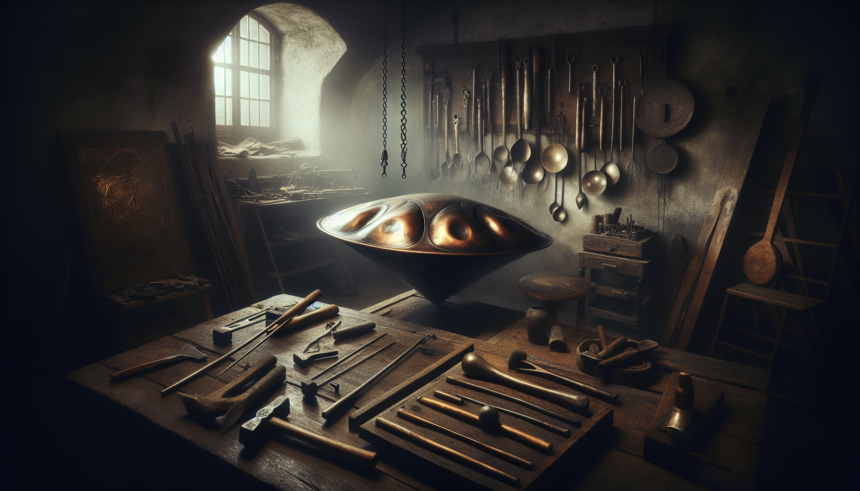<!DOCTYPE html>
<html lang="en">
<head>
<meta charset="UTF-8">
<meta name="viewport" content="width=device-width, initial-scale=1.0">
<title>Sculpting Silence: How the Hang Was Born</title>
</head>
<body>
<header>
<h1>Sculpting Silence: How the Hang Was Born</h1>
</header>
<main>
<section>
<p>
The Hang is an enigmatic and captivating musical instrument that has gained a dedicated following among musicians and enthusiasts worldwide. Also referred to as the handpan, the Hang is notable for its ethereal and soothing sounds, which seem to effortlessly bridge cultural and musical divides. Its creation is a fascinating story of innovation, passion, and a quest for transcendent sound.
</p>
<p>
The Hang was born in the city of Bern, Switzerland, in the early 21st century, a collaborative invention by Felix Rohner and Sabina Schärer of PANArt, a company initially renowned for crafting steel pans. These two innovative minds embarked on a mission to extend the tonal possibilities of percussion instruments, pushing the boundaries beyond traditional steel pan orchestras known primarily for their roots in Trinidad and Tobago. What they envisioned was not just an instrument but a vessel of sound that resonated with the depth and richness of a multitude of different traditions.
</p>
<p>
The journey began in the late 1990s when Felix and Sabina, inspired by their background in steelpan crafting, sought to explore the potential of the steel material by utilizing novel techniques. Initially, their aim was simple yet profound: to uncover a new, richer sound that could be coaxed from metal. The raw tonality of Trinidad steel drum culture was their guide, yet their aspiration was to create a new voice in the music world — something that could silence the noise of everyday life and allow the musician to sculpt silence itself.
</p>
<p>
The Hang (pronounced "hung", derived from the Bernese German word for "hand") was first introduced in 2001. Visually, it resembles two concave metal shells glued together with a hollow interior, reminiscent of a flying saucer. Through meticulous engineering, each Hang is carefully hand-hammered to create a central note surrounded by various ‘tone fields’ arranged in a circle. The central note, or 'Ding,' is pressed into the top shell, while the surrounding notes are each fine-tuned by hand to produce distinct pitches. The lower half, often referred to as the 'Gu', features an opening that helps to further enrich the resonances.
</p>
<p>
This unique construction allows the instrument to produce a wide ranged tonal spectrum beyond its size. The sound is warm and pure, with harmonic overtones that evoke a meditative and transcendental atmosphere. Unlike any other percussion instrument, the Hang's appeal lies not just in its notes but in the emotional journey it embarks upon with both the player and the listener. A skilled musician can bring out an astonishing fluidity and melodic expression within the paradigms of traditional percussion.
</p>
<p>
The construction process of the Hang brings together several disciplines, from metallurgy to acoustics. PANArt, using their pioneering technology known as 'Pang,' developed a special alloy called 'Pang', which enhances the steel's intrinsic musical properties. The development of 'Pang' marked a significant breakthrough, as it provided the instrument with enhanced acoustic qualities, especially in terms of sustain and tonal richness.
</p>
<p>
The popularity of the Hang has led many to view it as more than an instrument—it is seen as a medium of connection, both spiritually and musically. Through the Hang, musicians are able to craft a sound experience that is deeply personal, touching on elements of improvisation and individual expression. Many players describe their interaction with the instrument as both a powerful form of self-meditation and a poignant means to connect with others through the universal language of music.
</p>
<p>
However, the journey of the Hang has not been without its challenges. Demand for the original Hang instruments grew rapidly, overtaking PANArt's ability to produce them at scale. Moreover, the unique nature of each instrument, being hand-crafted and fine-tuned, meant that mass production would likely detract from its intended quality and personal nature. Consequently, PANArt ceased production of the Hang in 2014, choosing to focus instead on evolving their exploration of sound and resonance through other instruments like the Gubal and the Hang Gudu.
</p>
<p>
Despite the ceasing of Hang production by PANArt, the legacy of the instrument continues strong due to the emergence of similar instruments known as handpans. Inspired by the original Hang, craftsmen and players from around the world have adopted and adapted the unique design and philosophy behind it. This new family of instruments allows the spirit of the Hang to live on, fostering new communities of musicians and fans who find inspiration in its melodic silence.
</p>
<p>
Ultimately, the Hang stands as a testament to human creativity and the boundless pursuit of harmony and resonance. It is an instrument that was born from the soil of innovation, shaped by the fires of curiosity, and polished by the delicate art of handcrafting. It invites us to sculpt silence, giving a voice to that which often remains unspoken, and finding peace in the quiet interludes of life.
</p>
</section>
<section>
<h2>Conclusion</h2>
<p>
The story of the Hang is one of passion for sound, relentless pursuit of innovation, and a desire to connect with the human spirit through music. Though PANArt no longer produces the original Hang, its legacy remains influential across the world. Its entrancing sounds and unique design continue to inspire musicians, new instrument makers, and music lovers alike. Through its resonant tones and delicate craftsmanship, the Hang challenges us to find beauty in silence, encouraging a musical journey that transcends geographical and cultural barriers.
</p>
</section>
<section>
<h2>FAQs</h2>
<dl>
<dt>1. What is the difference between a Hang and a handpan?</dt>
<dd>
The Hang is the original instrument created by PANArt in Switzerland, featuring distinct engineering and metallurgy techniques. "Handpan" is a term used to describe other similar instruments that have been created following the Hang’s design but are made by different manufacturers.
</dd>
<dt>2. Why did PANArt stop producing the Hang?</dt>
<dd>
PANArt stopped producing the Hang in 2014 to focus on developing new instruments and exploring other areas of sound and resonance. The limited scale of production also made it challenging to meet the surging demand without compromising quality.
</dd>
<dt>3. How is a Hang made?</dt>
<dd>
Each Hang is meticulously hand-hammered from special steel alloy known as 'Pang', which is treated for its acoustic properties. The instrument features a central note with surrounding tone fields, each tuned by hand to specific pitches and harmonics.
</dd>
<dt>4. What are the playing techniques for a Hang?</dt>
<dd>
The Hang can be played using the hands, producing an array of harmonics and tones. Techniques vary from gentle tapping and slapping to more rhythmically complex patterns. The purity and versatility of the sound allow players to explore diverse musical expressions.
</dd>
<dt>5. Can anyone play the Hang?</dt>
<dd>
Yes, the instrument’s intuitive design and playing method make it accessible to musicians of all skill levels. While proficiency and complex techniques require practice, even beginners can produce beautiful and resonant sounds with basic motions.
</dd>
</dl>
</section>
</main>
</body>
</html>Sculpting Silence: How the Hang Was Born

Leave a comment




